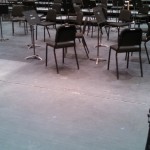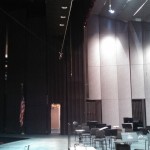On January 17th, 2015, hot on the heels of the Tulsa Youth Opera, the Tulsa Symphony Orchestra performed one of the all time greatest masterworks of the classical music cannon: The Requiem Mass in D Minor (K. 626) by W.A. Mozart. Also on this program was the Beethoven 8th Symphony. These pieces formed a program called “Simply Classical”. I got to record and mix this performance which will be broadcast on KWTU Radio in Tulsa, Oklahoma in March, 2015.
This performance required a slightly different approach to the staging and recording. The addition of a 100+ person chorus, four soloists, and a smaller orchestra meant the deployment of more microphones than is normally used to record a classical music ensemble. My normal orchestra recording set up is 6 to 8 microphones depending on soloist or other special instruments. To record this performance I used 15 microphones.
The main pair were 2 Neumann TLM 170s set to cardioid and hung from our lighting bridge approximately 12 feet over the stage. I used a length of 1/16″ black powder coated aircraft cable and a small VerLock to hold the mics in place and pull the stereo bar down stage about three feet behind the conductor. The mics were positioned so that their diaphragms were offset from each other left and right by 90 degrees. Five additional Neumann KM 184s were hung pointing straight down as spot mics for the rest of the orchestra: two either side fo the main pair about 15 feet either side of center. Three more were hung in a line further upstage from a batten over the stage and in between the shell ceilings. These three mics were positioned over the basses, the woodwinds and the timpani.
The chorus was miced with four AKG C414s on tall boom stands. The mics were set directly in front of the front chorus riser and spaced across the chorus so that each mic picked up one each of the four chorus sections: soprano, alto, tenor, and bass. The soloists were picked up with two AKG C451 small condenser mics. There were four soloists, a sproano, alto, tenor, and bass. I placed the mics a few feet down stage, and between the female and male soloists, respectively.
House mics were a pair of Neumann KM 184s, hung from our lighting cove position, approximately 35 or so feet from the stage. And I also recorded a feed from the wireless hand held mic used by the conductor for his speech prior to the performance of the Requiem, which brought me to 16 tracks total for this performance.
The Yamaha CL5 and it’s attached RIO3224D i/o racks were used as the audio interface and recorded into Protools via Dante Virtual Soundcard. Mixing took approximately 3 weeks and included manually time aligning the delayed audio from the house mics and pushing the chorus mics further back in the timeline to line up with the main pair of microphones. This dramatically increased the clarity and ineligibility of the chorus. I also used three separate reverb algorithms from the Waves IR-1 convolution reverb, one each for: orchestra, chorus, and soloists. A funny request came from the radio station after the December recording; that they wanted to hear more reverb in the recording. So I pushed it up a notch on this one to make the recording sound bigger.
March’s symphony program is the Mahler 6th Symphony, which includes the infamous “Mahler Box” and “Hammer of Fate”. I’m sure I will have an entire blog post devoted to the construction and recording of the box and hammer.
- Recording the Mozart Requiem
- Recording the Mozart Requiem
- Recording the Mozart Requiem
- Recording the Mozart Requiem
- Recording the Mozart Requiem





